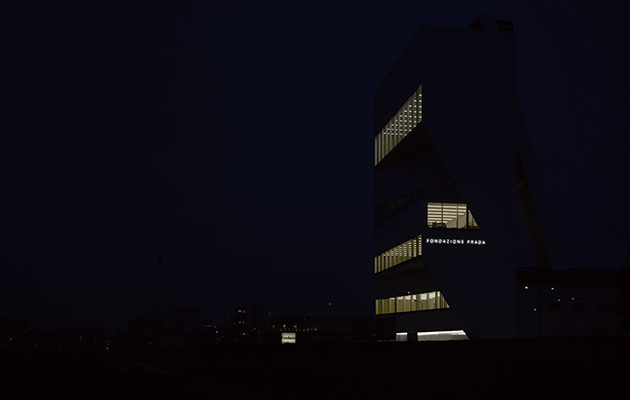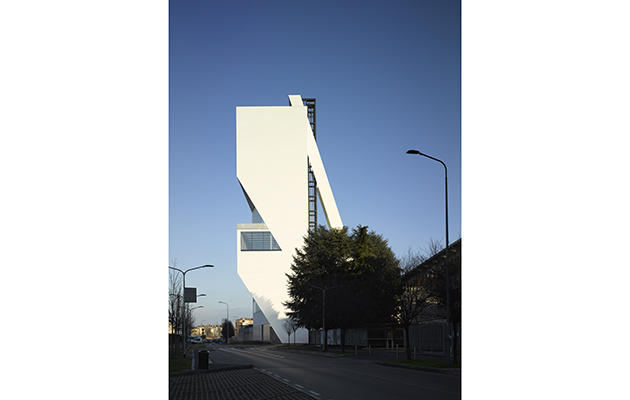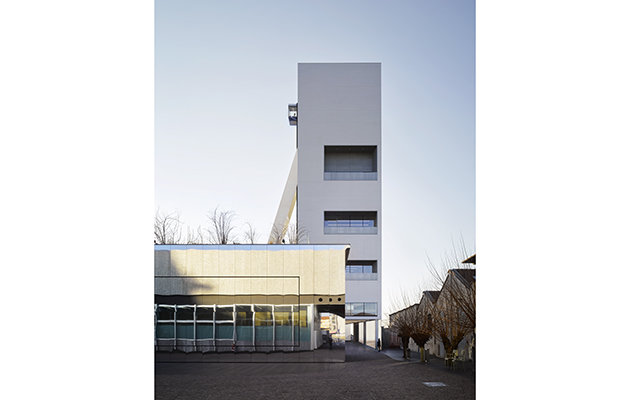![]() The new Prada Foundation tower by OMA.
The new Prada Foundation tower by OMA.
Milan had to wait a long time for its own contemporary art museum, but OMA’s Prada Foundation – now complete with the addition of a sculptural white-concrete tower – has quickly become a gallery of international significance, as well as a vital, quietly subversive piece of the city, writes Tim Abrahams. Photos: Bas Princen.
The new angular tower dominates the skyline of the often-ignored southern section of Milan. As one approaches from Porta Romana, the cantilever out over the pavement is clear although the long cranked column anchoring it in place on the other side is not. The Torre, the long-awaited nal phase of the Prada Foundation in Milan, announces the civic role of the building and how important the Foundation – which receives no public funding – has become to the city. Inside the compound of the converted distillery, the cobbled space between the galleries has been co-opted by the public. Sunbathers are seen in summer. The project is clearly dear to Rem Koolhaas co-founder of OMA; the Foundation’s architect: ‘I have to say, I didn’t realise that the terrain between these different buildings would be occupied and used.’
Even in three short years it is impossible to think that before the Prada Foundation, Milan had no contemporary art museum to speak of. Yes, there is the Galleria d’Arte Moderna, housed in a venerable palazzo and containing some important late 19th century work, but little of note from the 20th, let alone the 21st. Then there’s the Museo del Novecento, which is a true oddity. Named after the futurist movement raised in support of the Fascists it is remarkably coy about showing work from this period. It’s got some fantastic op art including installations from the 1960s, but it only shows a little contemporary work. The Padiglione d’Arte Contemporanea is exactly what it says it is: a pavilion.
 The Prada Foundation tower at night.
The Prada Foundation tower at night.
While visiting contemporary art galleries has become a bona de leisure activity throughout Europe in recent decades, a stamp of civic virility as much as tourist dollars, the absence of a gallery in Milan has weighed heavily on the collective mind of a city known for its visual culture in the elds of fashion and furniture. With the completion of the ten-storey tower, OMA has recast this historical oversight as a potential. ‘We didn’t see the absence of contemporary art museums as a lack but as a latency. To us Milan had a potential – an opportunity that we could address,’ Koolhaas says.
The answer as to how this situation should arise, and why it has only now been corrected, lies in the city’s history. Milan, in the modern period, has often been occupied by foreign powers. The Spanish, French and Austrians have all had a go at governing it. It is even rumoured that the Italians might try soon. It is neither the capital nor the industrial heart of the country and has thrived on an introspective tendency which in ects its built form, such as the predominant bourgeois housing type of enclosed courtyard or palazzo. It has also led to a reliance on small social and economic groupings. As the historian Jonathan Morris puts it, Milan is ‘more a Paris than a Manchester’ with large numbers of smaller artisans producing consumer goods for luxury markets rather than factories producing consumer goods. Prada, founded in 1913, is one such company.
It is not as if Milan hadn’t tried to rectify the situation in recent years. However, during the 1990s, as other European cities expanded their art museums and leisure economies, it was hamstrung rst by corruption and then by its vigorous dismantling during the Tangentopoli prosecutions. Since then it has been playing catch-up. Centres for contemporary art were included in two major regeneration schemes, one for Bovisa in 2007 and a well-developed proposal by Daniel Libeskind for City Life. But these were dropped ultimately due to a lack of resources.

The government of Milan effectively admitted its impotence when in 2011 architect Stefan Boeri, then the city councillor in charge of arts and culture, suggested that the state should help private artistic initiatives in any way that it was able. Several such initiatives had emerged in the city just before the turn of the millennium. The Prada Foundation was founded in 1995 with a donation from the huge pro ts that the company had made in the 1980s. Miucca Prada, the fashion label’s creative genius and the granddaughter of its founder, had taken one of the city’s many family-run businesses and turned it into an international brand through robust, strident fashion design and an international network of meticulously designed stores.
Miucca established the Foundation with her husband and business partner, Patrizio Bertelli, in order to pursue their own burgeoning interest in art. Before it became a physical space, and in friendly competition with other bodies such as the Fondazione Nicola Trussardi, it hosted singular exhibitions by artists like Tobias Rehberger or Thomas Demand in the otherwise secluded palazzi. This early itinerant period is key to understanding the Prada Foundation today. The architecture of the site declares how eager Miucca Prada and Bertelli – not to mention OMA – are to ensure it never ossifies.
‘We share with our clients a fundamental instinct; something that we all agree on is that we resist a large bureaucratic organisation,’ says Koolhaas. Although the original site had no obvious architectural or historical merit, OMA treated it as if it had tremendous value, going so far as to clad one building entirely in gold leaf. The e ect has the unsettling e ect of a de Chirico painting. It is ingenious in a curatorial sense as the distinct industrial character of each of the separate buildings – particularly the cisterns – has been preserved, prompting exhibiting artists or curators to think creatively and at scale. With buildings arrayed both around the perimeter of the compound and across it, they can be configured in bespoke ways for each exhibition.
To this kit has been added the new concrete tower. With its extra exhibition space the Prada Foundation is now the largest contemporary art museum in Europe to be supported by private funds. The new building, which looks like a concrete water tower as if it were designed by the futurist sculptor Umberto Boccioni, provides about 2,000sq m gallery space on top of the 11,000sq m the site already has. The tower crowns the achievements of the Prada Foundation and any lingering idea that the gallery is simply the play thing of wealthy fashion-cum-art tycoons is gone. This is a cultural institution with singular energy and breadth of interest.
Since it opened, the Foundation has quickly become a gallery of significance: showing not just contemporary art but also, perhaps more signi cantly, work that explores the artistic patrimony of Italy, particularly during the 20th century. Last year for example it hosted an artistic response to the graphics, interiors and set designs of Italian TV in the 1970s, curated and designed by the artist Francesco Vezzoli.
The tower will create an even greater sense of a cultural institution – not just in a symbolic way but with the extra exhibition space. In a subtle arrangement, it provides, along with restaurant and kitchen, six different galleries of increasing floor-to-ceiling height stacked on top of one another. As one ascends, the building gradually opens out to the sky and the city. The galleries, which have alternating rectangular and triangular oor plans and views from full-length windows to the north or west of the city, will house the Foundation’s permanent collection by artists such as Thomas Demand or Louise Bourgeois. ‘We made several proposals, which were based on the collection, before we started building,’ says Koolhaas. ‘We did one test on size, one using colour and another on chronology showing how different pieces might be located. The point is that there will be a relationship between different rooms and different art works as you go up or down the building.’

If it appears that the Foundation is ready to become part of the art establishment, one should be cautious. The relationship between the design of the building and the way in which the Foundation uses it is singular. ‘They react and resist against what we have done. We propose something and they think of ways they can subvert it,’ says Koolhaas. Hitherto the gallery’s amazing curatorial breadth has avoided easy categorisation. Its latest exhibition – its largest ever – is dedicated to Italian art from between the wars and the avant- garde’s collusion with the Fascists. Post Zang Tumb Tuuum. Art Life Politics: Italia 1918-1943 is a typically brave move by the Foundation.
By bringing together the best of the futurists and addressing one of the most controversial moments in Italy’s recent history, the institution assumes a national significance while remaining free of the ideological concerns that has discouraged major public institutions from exhibiting such works in greater number. Koolhaas who clearly sees himself as a privileged spectator of the Foundation’s work describes Post Zang Tumb Tuuum thus: ‘The exhibition has been extremely well organised and well considered. It is a very meticulous process, but importantly it is not part of a series of exhibitions. It’s one thing and then you have the next thing – this is the way they work and keep their freedom.’ The aim is to speak to a public without becoming an institution.
















